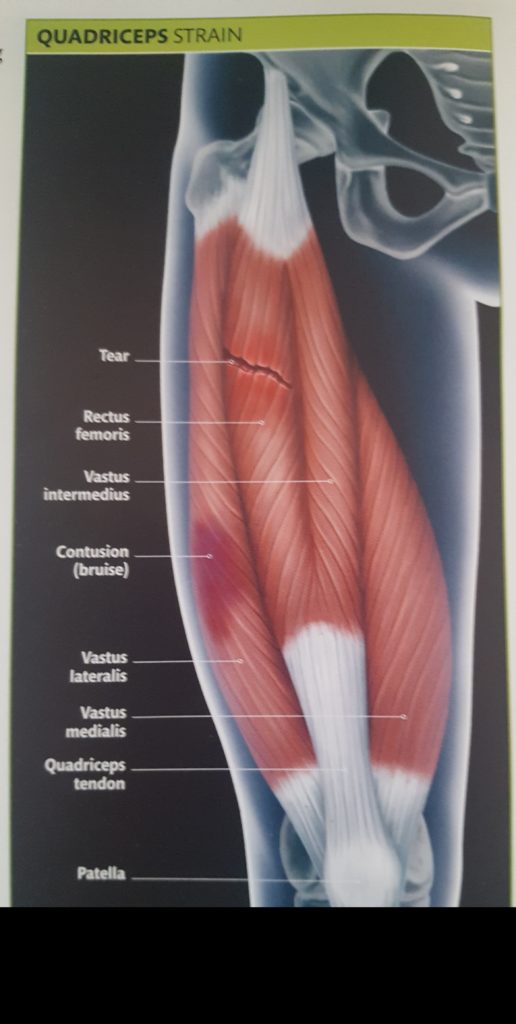Well, now we are in the middle of summer here in Ireland. The majority of sports enthusiasts ares busy taking part in their favourite sport! That being said, no matter how careful you are, or how correct and balanced your training is, occasionally injuries occur.
If you run, bike, swim or take part in field sports, a Quadriceps Injury can be one of the Usual Suspects when it comes to sports injuries. Chances are if your reading this article you already know where your Quadriceps Muscles are located, but just in case here follows the science bit;-)
 Where Are the Quadriceps Muscles Located.
Where Are the Quadriceps Muscles Located.
The Quadriceps are a group of four muscles at the front of the thigh. These muscles are heavily used in most sports such as running, cycling, football, rugby and swimming to name a few.
The Quadriceps muscles comprise Rectus Fermoris, which is the most superficial muscle and runs down the middle of your thigh to the Patella.
The Vastus Intermedius which lies under the Rectus Femoris. The Vastus Lateralis which lies on the outer aspect of the front of your thigh and the Vastus Medialis which lies toward the the inside of the front of your thigh.
If you are unsure just check out the picture on the left which I have borrowed from one of my medical texts. This small diagram has all the Quadriceps muscles labelled for you to check your injury site against.
Symptoms of Your Quadriceps Injury.
Symptoms of injury will vary slightly depending on the type of injury you have sustained and also how severe your injury is.
1.) There will be pain and localized swelling, for both strains and contusions(i.e. bangs or blows to your leg).
2.) If there has been a rupture of the muscle there may be a bump or lump within the muscle, or a gap in the muscle.
3.) If there has been a rupture to the Quadriceps Tendon, you may have heard a loud pop at the time of the injury. You will have pain and swelling and may be unable to straighten your leg.
4.) Depending on how severe your injury is, walking may be difficult and painful.
5.) For Minor Quadriceps Strains or Tears you may have pain and stiffness on movement.
How to Heal Your Quadriceps Strain.
In the initial stages after your Quadriceps Strain follow your RICE Procedure for 24 hours; Rest, Ice, Compression, Elevate. It is important that you rest your leg and Ice it every 2-3 hours for approximately 20 minutes at a time. A bandage will also give the area some support.
As soon as possible, for slight tears and strains it is recommended that you gently stretch the Quadriceps, during your healing. This helps to prevent the muscle shortening due to the formation of scar tissue. These gentle stretches allow your muscle to heal with minimal shortening, which therefore helps to prevent further injury. Check out the great short video by Live Strong that I have shared, explaining the basics of what to do after your injury.
After the acute stage of your injury you will find that regular sports massage coupled with strengthening exercises will aid with your recovery. Sports massage will help eliminate scar tissue and keep the muscle flexible. While exercises such as squats or cycling are great for strengthening the muscles after Quad injuries.
With minor strains and tears, following correct after care, exercises and physical therapy, healing time will be around 4- 6 weeks.
Caution For More Severe Injury.
If you suspect that you have sustained a serious rupture to your Quadriceps muscle or tendon, we recommend that attend you GP as soon as possible.
If you would like to discuss your injury or schedule an appointment for Sports Massage, contact me on 087-1904307.
